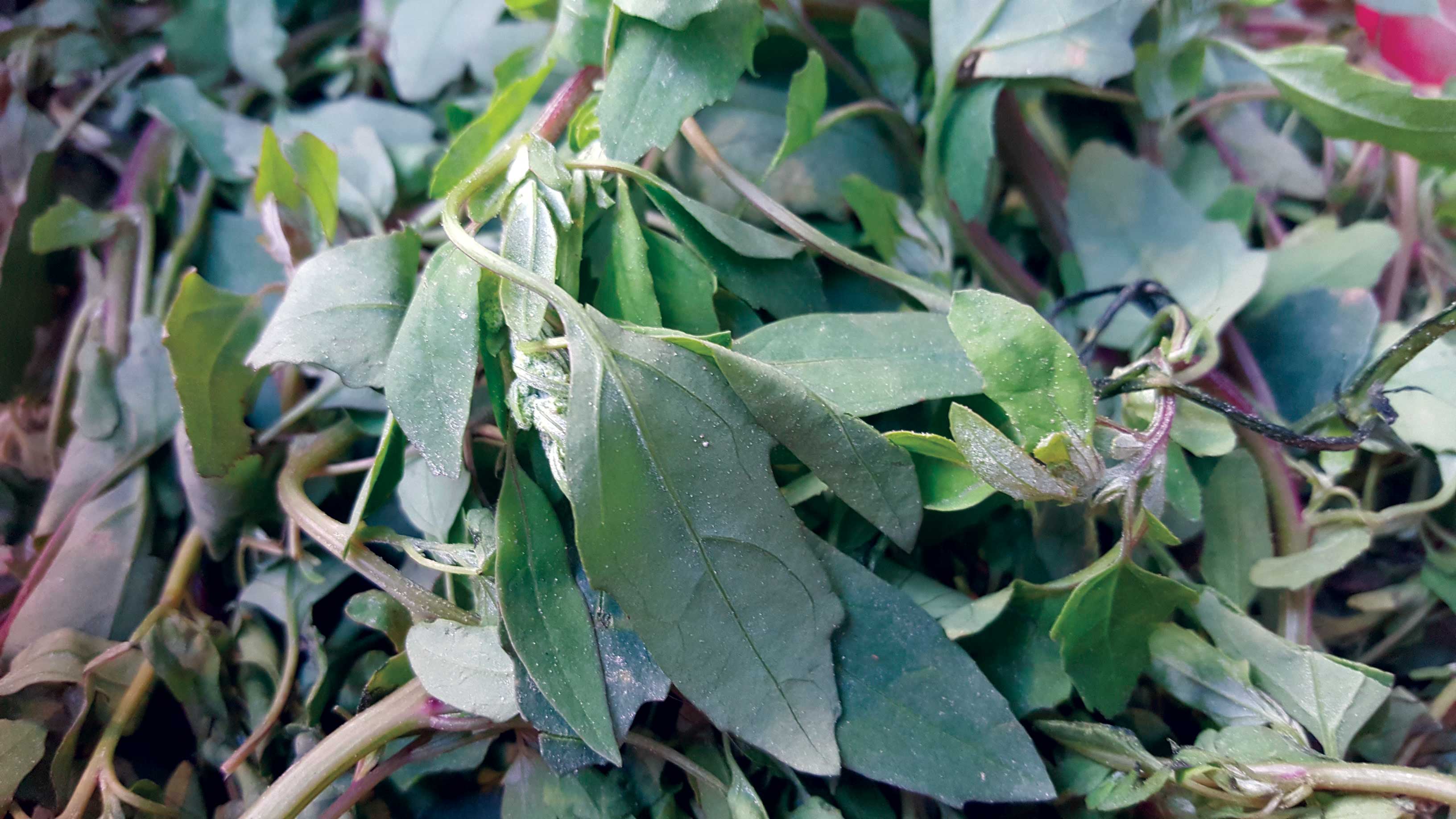If the article on Thak?li kh?na elsewhere in this month’s magazine has whet your appetite, here’s more, with easy to follow recipes. Some of the ethnic ‘Thak?liness’ necessary for authenticity may be missing, but if there’s no Thak?li restaurant around to feed you, it’s a start.
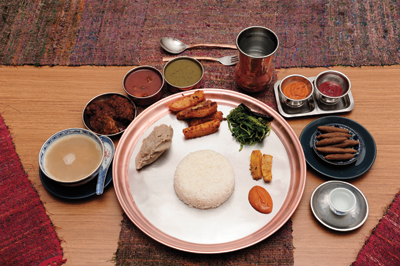 Thak?li food is basically d?l-bh?t-tharkari − lentils, rice and vegetables, with m?su (meat) for non-vegetarians. Most modern Thak?li restaurants, however, also offer mo-mos (meat dumplings) and thukpa (noodle soup). Sometimes buckwheat breads (like chap?tis or pancakes) may be served with the basic curry and buckwheat finger chips (k?chhyamba)as an appetizer. Desserts include sweet curd or phopké (fermented rice).
Thak?li food is basically d?l-bh?t-tharkari − lentils, rice and vegetables, with m?su (meat) for non-vegetarians. Most modern Thak?li restaurants, however, also offer mo-mos (meat dumplings) and thukpa (noodle soup). Sometimes buckwheat breads (like chap?tis or pancakes) may be served with the basic curry and buckwheat finger chips (k?chhyamba)as an appetizer. Desserts include sweet curd or phopké (fermented rice).
A typical Thak?li meal looks, and cooks, like this:
Appetizer
-
Buckwheat finger chips (k?chhyamba)
-
K?chhyamba is a popular snack food, often served while restaurant guests are waiting for the main meal.
-
Boil some water with a little ghee and salt to taste. Add buckwheat flour and cook into a thick gruel (called dhedo).
-
After it cools down, mix it up with your fingers in a bowl then roll the stiff dough out in the palm of your hand to form finger size pieces.
-
After they have cooled, fry them in hot oil, then serve with a hot tomato-and-timur relish.
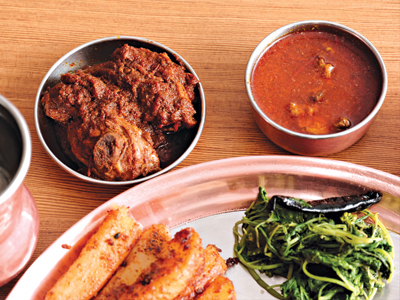 Main Course
Main Course
Rice (bh?t)
Long grain white basmati is most popular, boiled and served slightly fluffy. Wash the rice at least twice in cold water before cooking. Save the second starchy rinse water to thicken the lentil soup.
Lentil soup made from k?lo m?s (split urad d?l)
-
Wash the lentils and boil with a little ghee (ghiu) and turmeric (besar). Modern cooks use a pressure cooker. For thickening, cook them using the starchy second rinse rice water.
-
When done, transfer the lentils to an iron cooking pot and mash into a watery paste. By using an iron pot, the d?l’s preferred slightly green color comes out.
-
Add salt to taste, and a little shredded fresh ginger (?duwa).
-
The aromatic jimbu is added last, just before serving. Heat some ghee in a metal ladle and quickly fry a small sprinkling of dried jimbu in it. Then raise the lid from the simmering lentils and jam the ladle into the soup in a flash. The explosive noise is called “jhoin!” in Nepali, and gives it a delicious aroma.
Some Thak?lis say that adding jimbu to dal is more of a Brahmin/Chhetri custom. But, many Thak?li cooks I know do it. Back in the days when I first discovered the goodness of Thak?li kh?na in the trailside bhattis of central Nepal, as soon as I heard that “jhoin!” sound and smelled the aroma of jimbu and ghee in the lentils I knew that dinner was about to be served.
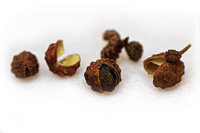 Timur (Zanthoxylum alatum)
Timur (Zanthoxylum alatum)
It is the dried outer pod of the berry of a tree in the prickly ash family. When crushed and added to relishes it exudes a pungent odor and tangy flavor that is the hallmark of Thakali kh?na. The dried berries are dark brown in color. Timur is widely used to flavor vegetables, soups and gravies. It is common throughout South Asia and Tibet, including China’s Szechuan province; hence, it is known outside of Nepal as ‘Szechuan pepper’, though it is unrelated to black pepper or chili pepper.
Timur is the signature spice of Thakali food, though doesn’t grow in Thak Khola. It is harvested in places like Dana (the Thakali salt traders’ winter village, in Myagdi District) and shipped north to the kitchens of Thak Khola and to markets elsewhere.
 Spicy fried potatoes (tareko ?lu)
Spicy fried potatoes (tareko ?lu)
Skin and boil potatoes (?lu) until about 90% cooked (they need to be a bit solid, not falling apart). Cool to room temperature, then slice them finger size (like French fries).
Heat oil in fry pan, add a little methi (fenugreek) and besar (turmeric); brown lightly. Use the turmeric sparingly, however, or it will turn the potatoes too yellow.
Drop the potato slices into the hot spicy oil, add a little ch?p (a chili and timur mix; below), finish cooking and serve hot.
Spinach (s?g)
-
One of the most popular spinach varieties in Nepal is broadleaf r?yo ko s?g developed on the Marpha Agricultural Farm in Thak Khola. Mustard greens (tori ko s?g) are also good.
-
Heat some cooking oil in a large pan. Add a little fenugreek and turmeric, and brown it lightly.
-
Meanwhile, wash and drain the spinach, then add it to the spiced hot oil in the cooking pan. It’s important that the oil is not too hot. How hot? See below.
-
-
Add salt to taste, and stir the spinach occasionally while it cooks. Don’t overcook it, and don’t put a lid on it.
My Thak?li friends say that the trick to retaining the distinctive bright green color of spinach is to cook it in an open pan with no lid. They also say to use turmeric sparingly; too much turns the food yellow and gives it a slightly unpleasant flavor.
In the villages, Thak?li mothers and aunties prefer cooking with mustard oil, or fresh ghee. In modern restaurants, however, soybean oil is favored for its mild taste and no odor.
Thak?li cooks will tell you that attention to timing and the temperature of the cooking oil is crucial. How hot? You learn by experience.
Meat (m?su)
Chicken, or goat (matan = ‘mutton’ on the menu).
-
Before cooking the meat, fry some chopped onion in hot oil until brown. But then, I’m told, some Thak?li cooks do not use onions. Your choice.
-
Chop the meat into finger-licking size chunks and add the pieces to the hot oil (with the onions, if you use them) and fry lightly in some salt, chili powder, turmeric, ginger and cumin powder (jira) to taste. Add water if you want gravy with the meat. (Gravy is called j?l.)
-
If you are using a commercial boiler chicken, add a little garlic paste and some tomato to flavor and thicken the sauce. Kh?nasseurs (my term) prefer ‘lokal’ (local) chicken. It tastes better, and with it you need only use a little ginger (no garlic, no tomato).
-
For goat meat, the cooking is the same but garlic is used mostly in winter, not in summer. Nobody told me why. Also note that timing is important, for if you add the garlic at the wrong time (too late), the meat may have a raw garlic taste.
For vegetarians: Cook carrots, cauliflower, peas, and green beans using basically the same spices as for meat (but go light on the turmeric).
 Dessert
Dessert
Fermented rice (phopké)
To make this delicious but slightly intoxicating dessert you need some ferment starter (marcha). It is similar to Tibetan chang (beer) starter or Sourdough starter. A little softened baker’s yeast will also do.
Thak?lis prefer a white rice that is slightly sticky (but not as sticky as Laotian or Cambodian sticky rice). Pearl rice is okay.
-
Wash the rice and throw out the first wash water. Then wash it again, this time stir-squeezing it a little with your hands to squeeze out more starch.
-
Boil the rice; no salt. Do not overcook.
-
After the cooked rice has cooled down put it into a glass or porcelain bowl and stir in the starter. Cover lightly and leave in a warm place for 2 to 3 days to ferment. (It is similar to making Sourdough, but takes a day or two longer).
-
When ready to serve, warm a little ghee in a pan, add the fermented rice and a little sugar to taste, and fry it lightly.
-
Serve warm in small cups, with dessert spoons.
-
Some Thak?li cooks fry tiny pieces of chirpi (hard yak cheese, the stringy variety), and serve the phopké over it, so that the two are eaten together. For special guests a little ghee is added to the warm phopké, to make it extra special.
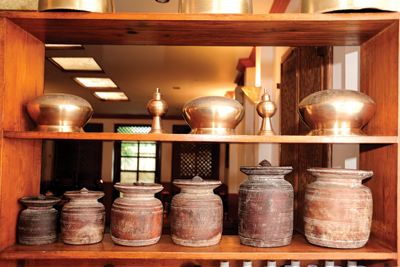 Condiments
Condiments
Hot chili pepper & timur (ch?p)
Ch?p (rhymes with ‘hope’) is one of the most distinctive flavors in Thak?li cooking. It has only three ingredients: red cayenne chili powder (kurs?ni), timur, and salt (n?n, rhymes with ‘soon’). It is used as you would use chili powder, but the timur powder enhances the flavor.
Fresh tomato relish (golbeda ko achh?r)
This mildly fiery achh?r “boosts the appetite.”
-
Fry small tomatoes (with skins on) in a pan with only enough oil to prevent sticking. Let it cool. If the skins fall off the tomatoes, leave them in the mix.
-
Mash or blend the tomatoes with ch?p (chili powder, timur and salt) to taste.
-
Place a small dollop on the side of the plate of rice, then watch as your guests’ taste it. They usually ask for more.
Traditionally, the tomatoes are mashed on a silauta, a flat grinding stone (mortar) with a pestle. Nowadays, most modern cooks use an electric blender. Vary the amount of ch?p according to how hot you want it. Each cook makes some slight variation to this simple recipe, paying particular attention to keep it hygienic and safe to eat.
And what’s the difference between achh?r and chatni? These two words are confusing and often used interchangeably. According to one Thak?li cook, chatni (chutney) comes from the Nepali word chatanee meaning ‘taste on the tongue’. As a relish it is prepared and served fresh. An achh?r, on the other hand, is prepared ahead of time (sometimes by several months) and preserved in a glass jar until served.
Fresh white radish pickle (mula ko achh?r)
This popular condiment is made from the long white radish called mula (or daikon internationally). Each cook has her own way of making this radish pickle to bring out the typical Thak?li taste.
-
Skin and slice the white radish finger size then rinse and drain in a colander. Sprinkle a little salt on the slices to help draw out the water, then stir the pieces around with your hands, an action called mula muchné or achh?r molné in Nepali.
-
Dry fry some brown sesame seeds (til), and grind them into a fine powder.
-
My Thak?li friends insist on using brown sesame, saying that black sesame has the wrong flavor. Alternatively, some use marijuana seeds (bhang ko bhiu) which has no narcotic effect but sure tastes good!
-
To the fried sesame or marijuana seed powder add some salt and chili powder to taste, then a little sour paste called tsuk, a type of vinegar made from limes or other citrus fruit.
-
Some Thak?li cooks used tsuk made from the juice of Sea Buckthorn berries (Hippophae rhamnoides). Sea Buckthorn grows in the arid Thak Khola region of Mustang District. It is super rich in Vitamin-C, with high nutritional and medicinal values. Fresh lemon tsuk will also work.
-
Mix the spices and radish pieces together in a large bowl.
-
In another pan heat a little oil with fenugreek and a little turmeric, and sprinkle some chopped green chilies (of a very hot variety) over the top. Then pour this mixture over the top of the spiced radish pieces. As you do so, it will sizzle and permeate down into the mix.
-
Cool and serve as a pickle condiment with a rice dinner.
This meal, once it is prepared and served, will put a bit of ‘Thak?liness’ into your life. If nothing else, just knowing what all that goes into Thak?li kh?na and how it is prepared will enhance your appreciation of good food the next time you go out to eat in an authentic Thak?li restaurant.







